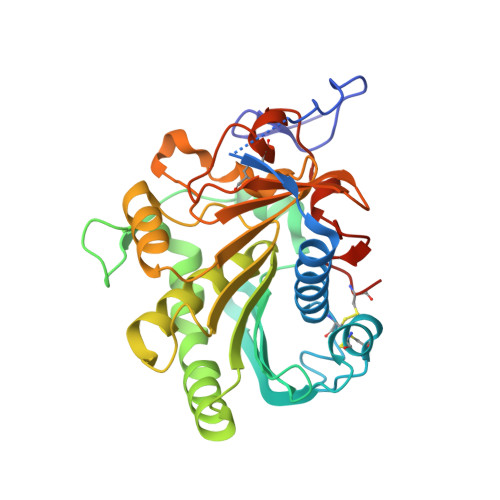Structural Basis by Which the N-Terminal Polypeptide Segment ofRhizopus chinensisLipase Regulates Its Substrate Binding Affinity.
Zhang, M., Yu, X.W., Xu, Y., Guo, R.T., Swapna, G.V.T., Szyperski, T., Hunt, J.F., Montelione, G.T.(2019) Biochemistry 58: 3943-3954
- PubMed: 31436959
- DOI: https://doi.org/10.1021/acs.biochem.9b00462
- Primary Citation of Related Structures:
6A0W - PubMed Abstract:
Members of an important group of industrial enzymes, Rhizopus lipases, exhibit valuable hydrolytic features that underlie their biological functions. Particularly important is their N-terminal polypeptide segment (NTPS), which is required for secretion and proper folding but is removed in the process of enzyme maturation. A second common feature of this class of lipases is the α-helical "lid", which regulates the accessibility of the substrate to the enzyme active site. Some Rhizopus lipases also exhibit "interfacial activation" by micelle and/or aggregate surfaces. While it has long been recognized that the NTPS is critical for function, its dynamic features have frustrated efforts to characterize its structure by X-ray crystallography. Here, we combine nuclear magnetic resonance spectroscopy and X-ray crystallography to determine the structure and dynamics of Rhizopus chinensis lipase (RCL) with its 27-residue NTPS prosequence (r27RCL). Both r27RCL and the truncated mature form of RCL (mRCL) exhibit biphasic interfacial activation kinetics with p -nitrophenyl butyrate ( p NPB). r27RCL exhibits a substrate binding affinity significantly lower than that of mRCL due to stabilization of the closed lid conformation by the NTPS. In contrast to previous predictions, the NTPS does not enhance lipase activity by increasing surface hydrophobicity but rather inhibits activity by forming conserved interactions with both the closed lid and the core protein structure. Single-site mutations and kinetic studies were used to confirm that the NTPS serves as internal competitive inhibitor and to develop a model of the associated process of interfacial activation. These structure-function studies provide the basis for engineering RCL lipases with enhanced catalytic activities.
Organizational Affiliation:
Key Laboratory of Industrial Biotechnology, Ministry of Education, School of Biotechnology , Jiangnan University , Wuxi 214122 , People's Republic of China.















